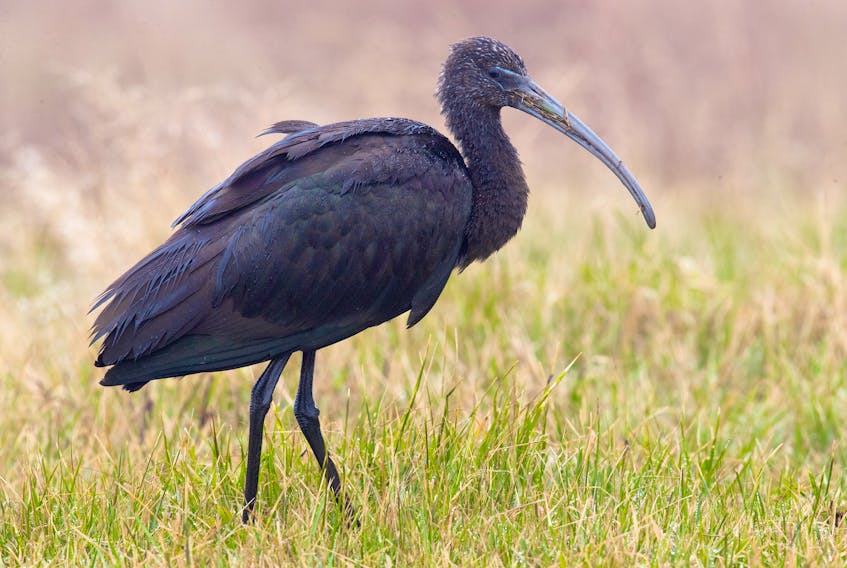There is nothing about a glossy ibis that looks like any of the regular crowd of birds we know in Newfoundland and Labrador.
It is a long-legged bird about the size of a small dark heron. It has a long neck like a heron. But that bill? That long sickle-shaped bill is the mark of an ibis.
A glossy ibis always gets noticed during its rare visits to our province.
Warm southwest winds in early October are probably responsible for carrying somewhere between three and five different glossy ibis to the Avalon Peninsula.
It is difficult to know if the two photographed on a lawn in Carbonear on Oct. 6 and posted to the Newfoundland Birding Facebook group by Erin O’Grady were not also the same birds as the single glossy ibis seen by many people on backyard lawns in Shearstown, Conception Bay starting on Oct. 8 when Sarah Webber first reported it. And the one photographed at Old Perlican and posted on Facebook by Steve Green on Oct 11. The glossy ibis that Cliff Doran saw come in to landing at Cape Race lighthouse on Oct.16 was different from all the rest.
Anyhow, whether it was three or five, seeing just one glossy ibis is a thrill for the birdwatcher and backyard watcher alike.
The glossy ibis is rare in Canada but shows up somewhere in our province almost every year. Its normal range is the coastal United States from the Gulf of Mexico to New Jersey. It is quite common within its range where it is usually seen in flocks.
They prefer to feed in mucky coastal marshes. With the long powerful bill, they probe deep into the mud farther than other birds can go seeking out marine worms and other goodies.
During their visit to the Avalon, they are resorting to lawns with soft soil where they dig out earthworms and any other goodies they can find.
The odds are very good they will replenish their energy reserve well enough to reach their destination. Without placing some kind of tracking device on the birds, we can only speculate the ibises will get back to where they came from.
The photograph of the glossy ibis with this column is from Cape Race.
I watched the bird continuously probing the lawns getting plenty of earthworms, caterpillars and slugs to eat. You can see by the dirt and grass accumulated on its bill that it has been working hard.
The-wind driven drizzle left droplets of water on the bird’s water-resistant feathers. They are called glossy ibis because in spring time their body plumage becomes a rich maroon with iridescent greens and reds on the wing.
Will these glossy ibis make it back to their normal home?
They have been feeding very well. And they need to feed well to make up for the lost body fuel burned up flying so far out of range.
The odds are very good they will replenish their energy reserve well enough to reach their destination. Without placing some kind of tracking device on the birds, we can only speculate the ibises will get back to where they came from.
Other rare birds
After the great crested flycatchers and all the other rare birds reported in the last column there was a 48-hour period of clear skies and light northeast winds.
Most of those rare birds departed with the favourable weather for migration.
However, there have still been enough interesting birds around to keep the rare bird chasers entertained.
A great egret spotted by Anne Hughes at Long Pond, St John’s kept the photographers on the run. A common gallinule found by John Alexander at Mundy Pond, St John’s was more co-operative for all.
A lovely male black-throated blue warbler found by Blair Fleming in dense vegetation at Kelly’s Brook, St John’s was a real crowd pleaser. While it moved back and forth through a very dense bed of stream-side shrubbery, it was at least contained to small area allowing everyone with patience to get a look at this attractive warbler.
Jared Clarke lucked into a marsh wren at Grates Cove.
Green light for bird feeders
Some of you have been asking if it is OK to restart your bird feeders. There is good news.
The Canadian Wildlife Health Cooperative reports a lot fewer trichomonosis (frounce) cases in Atlantic Canada in 2020 than recent years. There were no suspected cases reported in Newfoundland and Labrador in 2020.
With colder temperatures, a few heavy frosts in some areas and the low parasite occurrences, the Canadian Wildlife Cooperative feels fairly comfortable to give the “green light” for Atlantic Canada to go ahead to feed seeds and suet to the birds.
However, they suggest keeping an eye on your feeder birds, especially purple finches and report obvious sickness.
I know many of you including my household are already having fun feeding peanuts to the blue jays. Enjoy the birds of autumn.
Bruce Mactavish is an environmental consultant and avid birdwatcher. He can be reached at [email protected].









